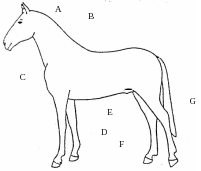Protecting your Horse from Ticks Info Sheet
Ticks Info Sheet.doc
Equine 2015 Study
Protecting your Horse from Ticks Info Sheet
OMB: 0579-0269
![]()
Veterinary Services
Center for Epidemiology and Animal Health August 2014
_________________________________________________________________________________________________________________________
Protecting Your Horse From Ticks
Ticks live in forests, grasslands, and scrub- brush areas, attaching to animals or people as they pass by. Many species of ticks can infest horses, and horses with heavy tick infestations often display poor body condition and even anemia. Ticks can also transmit disease agents to your horse. In addition, the site of the “bite” often irritates the horse, causing it to scratch or rub the site, which often leaves an open wound that can become inflamed and infected. Rarely, an attached tick causes progressive paralysis.
Protect Your Horse
Prompt and safe removal of ticks from your horse can be accomplished using a tick-removal tool designed specifically for the job. Before riding and while grooming, give special attention to the area under the tail; along the mane; warm/dark, thin-skinned areas such as between the upper thighs; on the udder or sheath; behind the elbows; and around the throatlatch and ears.

_____________________
Privacy
A.
Ears
B. Mane or crest
C. Jawline
D.
Elbows and girth area
E. Sheath or udder
F. Between upper and inner thighs
G. Tailhead and under tail
After riding check your horse for ticks again. Apply tick control pesticides (as permitted by label directions) to your horse, especially if it is being returned to tick-friendly pastures with shade or tall grass/brush/weeds.
Protect Your Property
Remove leaf litter, brush, and weeds at the edge of lawns and pastures.
Create a 9-foot cleared boundary on equine trails and pastures.
Discourage contact with tick-carrying animals by storing grains in tightly sealed containers.
Keep your pasture at a length that allows for adequate equine forage but still reduces tick populations.
Prevent horses from grazing in wooded areas by installing fencing.
For more information, contact:
USDA–APHIS–VS–CEAH–NAHMS
NRRC Building B, M.S. 2E7
2150 Centre Avenue
Fort Collins, CO 80526-8117
970.494.7000
http://nahms.aphis.usda.gov
The U.S. Department of Agriculture (USDA) prohibits discrimination in all its programs and activities on the basis of race, color, national origin, age, disability, and where applicable, sex, marital status, familial status, parental status, religion, sexual orientation, genetic information, political beliefs,
reprisal, or because all or part of an individual’s income is derived from any public assistance program. (Not all prohibited bases apply to all programs.) Persons with disabilities who require alternative means for communication of program information (Braille, large print, audiotape, etc.) should contact USDA’s TARGET Center at (202) 720–2600 (voice and TDD). To file a complaint of discrimination, write to USDA, Director, Office of Civil Rights, 1400 Independence Avenue, S.W., Washington, D.C. 20250–9410, or call (800) 795–3272 (voice) or (202) 720–6382 (TDD). USDA is an equal opportunity provider and employer.
Mention of companies or commercial products does not imply recommendation or endorsement by the U.S. Department of Agriculture over others not mentioned. USDA neither guarantees nor warrants the standard of any product mentioned. Product names are mentioned solely to report factually on available data and to provide specific information.
U nited
States Department of Agriculture • Animal and Plant Health
Inspection Service • Safeguarding
American Agriculture
nited
States Department of Agriculture • Animal and Plant Health
Inspection Service • Safeguarding
American Agriculture
| File Type | application/msword |
| Author | bdoty |
| Last Modified By | Doty, Brad C - APHIS |
| File Modified | 2014-09-09 |
| File Created | 2014-08-28 |
© 2026 OMB.report | Privacy Policy